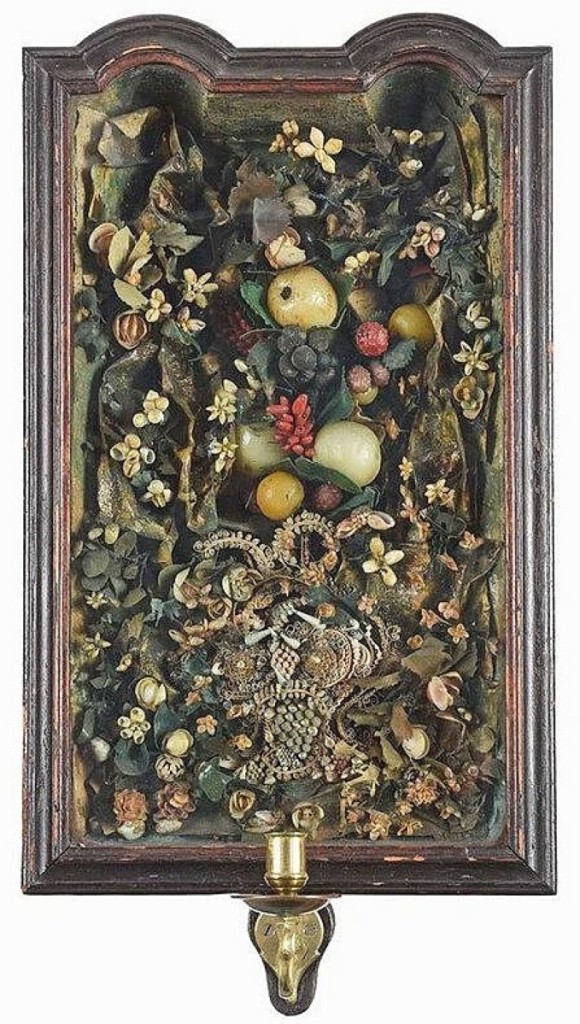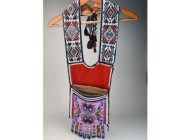By Greg Smith
ASHEVILLE, N.C. – More than doubling the $90,000 high estimate at Brunk Auctions’ three-day Premier Auction December 3-5 was an American Queen Anne filigree and wax sconce that sold for $221,000. The auction house wrote that it was probably made in Boston and dated to the early to mid-Eighteenth Century. The piece featured an elaborate display of wax fruit, shell flowers and cut fabric leaves inside of a scrolled paper gilt-edged urn on a textured papered ground with scattered mica or glass chips. A wood analysis revealed that the double arched painted white pine shadowbox was original though the brass candle arm was replaced.
“Some might assume these are English,” said Brunk’s decorative arts and textiles specialist Karen Swager, “but when the wood analysis test showed the case was American pine, that was a game changer.”
The work sold to an American private bidder, underbid on the phone by Philadelphia dealer Amy Finkel. It had provenance to Pennsylvania dealer Joe Kindig, who sold it into the collection of Dudley and Constance Godfrey.
Swager said, “I had never seen one before when we got it, so we started looking into some of the comps and how rare they are. We realized it might do well, but we were pleasantly surprised it did what it did. They are hard to find, it’s a strong but limited market.”
Brunk began selling the Godfrey collection in its October sale, working through Sixteenth and Seventeenth Century needleworks as well as early brass candlesticks. This example was a crossover piece, or a combination of both of those craft traditions.
Swager said, “They were pretty discerning collectors, so they had some very good things come up for sale.”
The description noted, “American filigree or quillwork sconces are rare and most of the approximately 25 documented double arch examples are currently in important institutional collections, including Colonial Williamsburg, Metropolitan Museum of Art, and Winterthur Museum… Waxwork variants are even more rare and most have been attributed to schoolgirls in the Boston area during the early Eighteenth Century.”
In a 2006 issue of Antiques & Fine Art, Anne Vogel wrote that there were only eight waxworks known to exist from colonial times, only six appearing in sconce-form like the present example, half of which were in the vertical rectangular form.
Vogel wrote, “Waxworks have been dated through estate inventories as well as documented examples, and newspaper advertisements from Boston finishing schools confirm the making of waxworks as part of their curricula. The works even share enough formal and stylistic elements to suggest the same teacher or school, with most sharing allegorical themes with well-known paintings, mezzotints and needlework of the period.”
She continued, “Extraordinary skill and agility were required to carefully attach small wires to the wax figures, fruits and flowers, then anchor those forms to wooden posts, cover the posts with green tape for camouflage, and hide those construction techniques with more wax decoration. The figures themselves may have been simple in form but their assembled compositions were complex, akin to an elaborate theater set or three-dimensional puzzle.”
Swager said that this piece had been in the Godfrey’s collection for decades and was likely not included in any reference count as far as they knew.
“These young girls were likely well-to-do young women,” Swager said. “It took resources to make the cases, to buy the paper, put together the wax, and fix the candle arms that were created by silversmiths in the area.”
On the sale, the firm’s president Andrew Brunk said, “It was an esoteric thing, but obviously a combination of rarity and quality.”
For additional information, www.brunkauctions.com or 828-254-6846.





